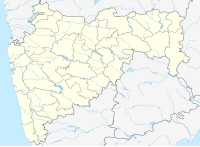Ajinkyatara
| Ajinkyatara Fort अजिंक्यतारा किल्ला |
|
|---|---|
| Part of Former Maratha Empire, now Maharashtra | |
| Satara District, Maharashtra (near Satara) |
|

Entrance to Ajinkyatara fort
|
|
| Coordinates | 17°24′N 73°35′E / 17.40°N 73.59°E |
| Type | Hill fort |
| Height | 1,356 metres (4,400 ft) ASL |
| Site information | |
| Owner | Government of India |
| Open to the public |
Yes |
| Site history | |
| Materials | Stone, Lead |
| Garrison information | |
| Past commanders |
Shivaji |
| Occupants | Chattrapati Shahu |
Ajinkyatara (मराठी:अजिंक्यतारा) ( meaning "The Impregnable Star") is a fort on one of the seven mountains surrounding the city of Satara in the Sahayadri Mountains of Maharashtra, India. It is a 16th-century fort that was called "Ajimtara" during Aurangzeb regime and was based on Aurangzeb son's name, Ajim. Marathi novelist Narayan Hari Apte named the fort "Ajinkyatara", when he wrote his very first novel on the same name (first published in 1909- Ref: His interview published in marathi Pratishthan Monthly in December 1970 issue). Now also holds the television tower for the city of Satara. This fort has been the place where several pivotal moments in Maratha history took place.
The fort is located at Ajinkyatara Mountain, which is 3,300 feet high. As the fort is in the higher altitude, visitors can enjoy a magnificent view of the entire Satara city.
In 1708, Shahu Maharaj won Ajinkyatara, which remained with the Marathas till 1818. The Ajinkyatara fort is a major historic place of Maharashtra, and was very vital as one could keep watch over the entire South Maharashtra.
This was the place where Tarabai was imprisoned by Shahu.
The fortress is also mentioned in Nathmadhav's novel Veer Dhaval, in which the eponymous protagonist, a vassal of the Chalukyas, is the rightful master of the fort (and takes final possession of it at the novel's end) which has been under the misrule of his uncle Chanda Varma, who usurped the fort after murdering the protagonist's father Keerti Varma.
One can easily reach Ajinkyatara by road, train or plane.
...
Wikipedia

